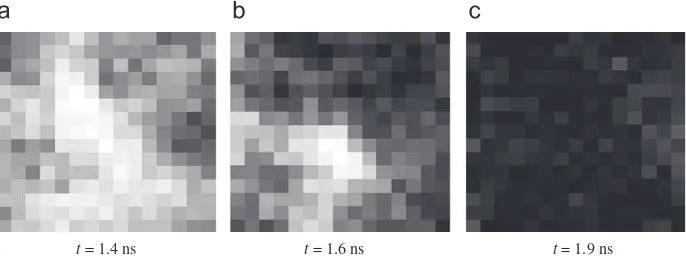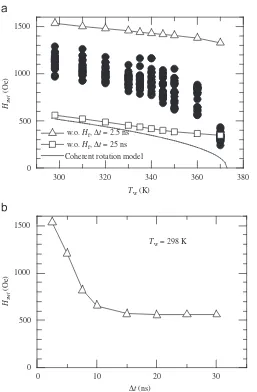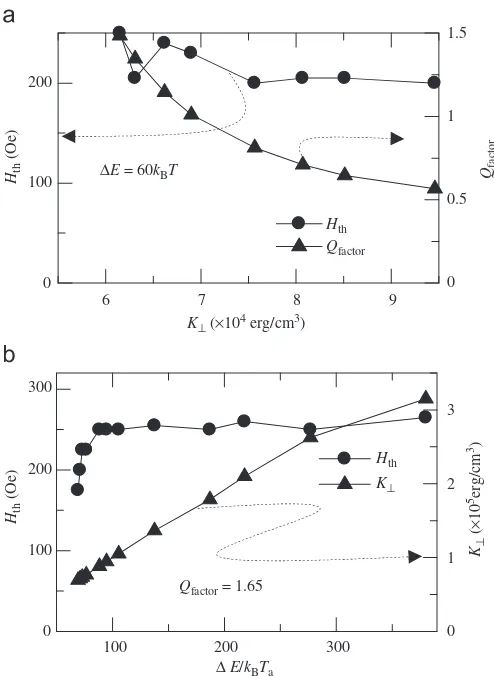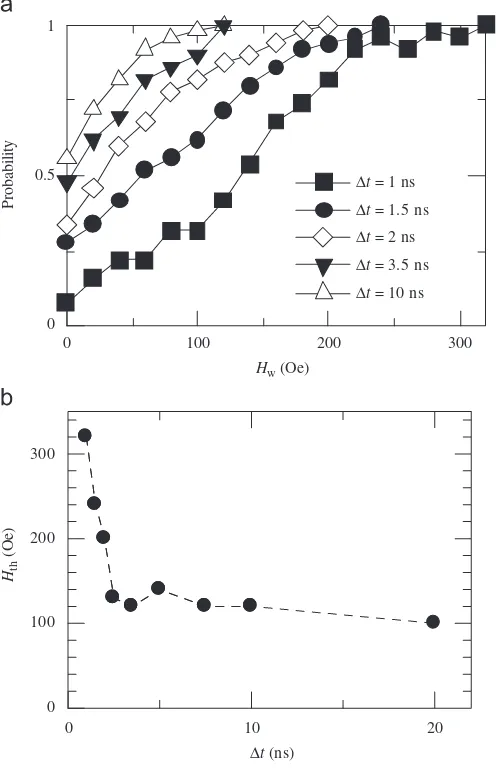Other uses, including reproduction and distribution, or selling or
licensing copies, or posting to personal, institutional or third party
websites are prohibited.
In most cases authors are permitted to post their version of the
article (e.g. in Word or Tex form) to their personal website or
institutional repository. Authors requiring further information
regarding Elsevier’s archiving and manuscript policies are
encouraged to visit:
Stochastic simulation of thermally assisted magnetization reversal in
sub-100 nm dots with perpendicular anisotropy
Budi Purnama
, Masashi Koga, Yukio Nozaki, Kimihide Matsuyama
Kyushu University, Department of Electronics, 744 Motooka Nishi-ku, Fukuoka 819-0395, Japan
a r t i c l e
i n f o
Article history: Received 4 July 2008 Received in revised form 7 October 2008
Available online 7 December 2008
Keywords:
Thermally assisted magnetization reversal Reduced barrier writing
Curie point writing Perpendicular anisotropy
a b s t r a c t
Thermally assisted magnetization reversal of sub-100 nm dots with perpendicular anisotropy has been investigated using a micromagnetic Langevin model. The performance of the two different reversal modes of (i) a reduced barrier writing scheme and (ii) a Curie point writing scheme are compared. For the reduced barrier writing scheme, the switching field Hswtdecreases with an increase in writing temperature but is still larger than that of the Curie point writing scheme. For the Curie point writing scheme, the required threshold fieldHth, evaluated from 50 simulation results, saturates at a value, which is not simply related to the energy barrier height. The value ofHthincreases with a decrease in cooling time owing to the dynamic aspects of the magnetic ordering process. Dependence ofHthon material parameters and dot sizes has been systematically studied.
&2008 Elsevier B.V. All rights reserved.
1. Introduction
To realize magnetic random access memories (MRAMs) with high bit density of the order of several Gbits/cm2and high transfer
rates of the order of several Gbits/s, the size of magnetic memory dots should be in the sub-100 nm order and switching time of several nanosecond [1–4]. As a magnetic memory dot is down-sized to the sub-100 nm scale, the energy barrier
D
E for magnetization switching tends to become smaller; therefore, a material with high magnetic anisotropy is required. Materials with high perpendicular anisotropy ensure thermal stability that have no scaling limitation in their cell aspect ratio are promising candidate for this purpose. Ultra-thin films having small lateral dot size made of a magnetic material with perpendicular anisotropy can reverse their direction of magnetization through coherent rotation[5], however, the application of a large magnetic field [6] is required for switching. One approach to obtain magnetization reversal in low bias fields is by using the thermally assisted magnetization process [7,8], which implies that the reversal field is temporally reduced by heating of memory cells. In this study, the performance of two different reversal modes of (i) reduced barrier writing and (ii) Curie point writing are compared. Switching fields in the reduced barrier writing scheme are evaluated by considering the energy barrier fluctuation caused by thermal effects. The threshold value of the external fieldrequired for aligning the magnetization along the field direction is also evaluated for the Curie point writing scheme.
2. Model
In these micromagnetic simulations, a finite-grid approxima-tion was adopted, where a parallelepiped dot with perpendicular anisotropy was discretized into a two-dimensional array of a rectangular numerical grid. The grid size was chosen to be smaller than the domain wall width. The demagnetization fields are calculated by integrating those from apparent surface magnetic charges on boundary of each grid element [9]. Temporal evolutions of thermally assisted writing processes have been numerically investigated for reduced barrier writing and Curie point writing. For reduced barrier writing, the calculation starts from a uniformly magnetized state at an ambient temperature of 298 K. Simulations of Curie point writing start from just below the Curie temperature Tc, wherein randomly
distributed magnetization configurations are used for the initial states. To evaluate the stochastic probability of aligning the magnetization along the field direction, simulations are per-formed for 50 different random field sequences. An approximation of the thermal fluctuation effect occurring during magnetization is taken into account by involving randomly oriented effective fields with zero mean value, /Hfi(t)S¼0, in the following Landau–Lifshitz–Gilbert (LLG) equation:
dMi
dt ¼ j
g
jM iHieffþ
a
Ms
MidM
i
dt (1)
Contents lists available atScienceDirect
journal homepage:www.elsevier.com/locate/jmmm
Journal of Magnetism and Magnetic Materials
0304-8853/$ - see front matter&2008 Elsevier B.V. All rights reserved. doi:10.1016/j.jmmm.2008.12.003
Corresponding author. Tel.: +81 92 642 3919; fax: +81 92 642 3971.
The strength of the random field due to the thermal fluctua-tion effect is calculated by using the fluctuafluctua-tion dissipafluctua-tion theorem[10].
s
¼ffiffiffiffiffiffiffiffiffiffiffiffiffiffiffiffiffi
2kBT
a
g
VMsD
t s(2)
where
a
is the Gilbert damping constant (¼0.3),g
¼1.76107(Oe1s1) is the Gyromagnetic ratio,
Vis the volume of the sub-cell and the time step of the integration time methods, dt is 0.25 ps. In our model, an amorphous ferrimagnetic material is considered as a composition of magnetic nanocells, so that the second-power temperature dependence with the thermally reduced magnetization was assumed for both the exchange stiffness constant,A, and the perpendicular crystalline anisotropy,
K? [11]: A(T)¼A
(0)(
Ms(T)/Ms(0))2, K?(T)¼K?
(0)(
Ms(T)/Ms(0))2. A
simple empirical temperature dependence of the magnetization,
Ms(T)¼Ms(0)(1T/Tc)0.5, is adopted, which reasonably fits the
experimental result. Other material parameters used in the simulation are as follows:A¼1.010–7erg/cm (at 298 K) [12],
Tc¼373 K. Any spatial disorder is not assumed for the magnetic
parameters includingMs, A, K? and the easy axis direction. In most of the following simulations, the grid size of 3.3 nm was used,MsandK?values are set such that the energy barrier height
D
EX60kBTa(Tais an ambient temperature of 298 K) to ensure thatpractical thermal stability is achieved.
3. Results and discussions
Fig. 1(a) illustrates the simulation model of the reduced barrier writing scheme. In this model, the uniformly magnetized state is set as the initial condition. The uniform reversal field is then linearly increased with the increasing time periods
D
tat a fixed temperatureTw. The value ofD
tand the final external field arechosen to be 2.5 ns and 1400 Oe, respectively. The resultant field ramp rate is 560 Oe/ns. Fig. 1(b) shows the typical stochastic switching properties due to variation in the thermal fluctuation effects of 20 random field sequences atTw¼350 K.
Simulations were performed for a nanodot of 505020 nm3
volume having the following magnetic properties:K?¼8.810
4
erg/cm3and 4
p
Ms¼1.9 kG. The switching fieldHswtis defined as
a field value at which the average magnetization becomes zero during the magnetization reversal process. The energy barrier
D
Ebetween the bi-stable magnetization states is also evaluated from the magnetization reversal simulation, which is defined as a deference between the maximum and the minimum value of the total magnetic energy during the magnetization reversal, includ-ing the exchange, demagnetizinclud-ing and anisotropy energy terms. A particular thermal fluctuation sequence corresponds to a parti-cular type of the energy barrier
D
E, thus reflecting the random aspects. Therefore, the field required for switching Hswtin thereduced barrier writing scheme strongly depends on the variation in the micromagnetic configuration caused by the thermal effects modelled by the random field. In a simple coherent rotation model, the switching field simply depends on the energy barrier T
Δt
298 K
H
HW
0
0
t
t Δt
TW
0 50 100 150
0 500
1000 Tw = 350 K
Hswt
(Oe)
Δ E/kBTw
Fig. 1.(a) Simulation model of the reduced barrier writing scheme. (b) Fluctuation
of energy barrierDEand switching fieldHswtatTw¼350 K for 20 simulation runs
assuming different random field sequences.
t = 1.4 ns t = 1.6 ns t = 1.9 ns
Fig. 2.Micromagnetic configurations in the reduced barrier writing scheme: (a) domain nucleation, (b) domain expansion and (c) domain annihilation. The grey scale
height. However, we observed that Hswt takes different values.
This may be because local pinning effects dominateHswt, which is
not related to the averaged
D
E due to the stochastic aspect in the thermally assisted magnetization switching. Fig. 2 shows typical micromagnetic configurations of non-uniform magnetization reversal during the reduced barrier writing at 350 K for the dot shown inFig. 1(b). The magnetization switching started from domain nucleation (a) then domain expansion (b) and domain annihilation.Considering the stochastic aspect of the reduced barrier writing scheme, simulations are performed using 20 different random field sequences at each temperature, as shown inFig. 3(a). The significant scattering ofHswtcan be attributed to the variation
in an individual random field series. In comparison, simulations are also performed without random fields for
D
t¼2.5 and 25 ns, by considering only the temperature dependence of material parameters. As demonstrated in the figure, the thermal fluctua-tion, modelled by random fields, effectively assists the switching events and leads to a considerable reduction in Hswt, it also300 320 340 360 380
0 500 1000 1500
Hswt
(Oe)
w.o. Hf, Δt = 2.5 ns w.o. Hf, Δt = 25 ns Coherent rotation model
0 10 20 30
0 500 1000 1500
Hswt
(Oe)
Tw (K)
Δt (ns)
Tw = 298 K
Fig. 3.(a) Dependence of switching fieldHswton temperature computed for
different simulation models. (b) Dependence of Hswton increasing Dtof the
external field.
T
Δt TC
H
Hw
0
298 K 0
t
t Δt
0 200 400 600
0 0.5 1
Probability
I = M
II = M
Dot size = 20 × 20 nm2
II
I
Hth
0 50 100
0 0.5 1
Probability
I II
III
I = M
II = M
III = M
Dot size = 50 × 50 nm2
Hth
Hw (Oe)
Hw (Oe)
Fig. 4.(a) Simulation model of Curie point writing scheme. The probability of final
magnetization states occurring after writing for dots with different sizes and material parameters: (b) 202020 nm3,
K?¼2.93105erg/cm3 and
4pMs¼1.88 kG, (c) 505020 nm3,K?
¼8.73104erg/cm3and 4pM
introduces a dispersion ofHswtvalues. The significant difference in
Hswt for reference simulations with
D
t¼2.5 and 25 ns can beexplained in terms of the dynamic coercivity.Fig. 3(b) showsHswt
evaluated for various
D
t at 298 K, where random fields are not taken into account. The value ofHswtdecreases with an increase inD
tand reaches a minimum value of 600 Oe atD
t¼15 ns, where the switching behaviour becomes quasi-static. The quasi-static switching field at 298 K is reasonably consistent with a simple theoretical prediction based on the coherent rotation model. The demagnetization coefficient of the simulated dot (505020 nm3) along the perpendicular axis is estimated at 0.57. Thesimulated values ofHswt(open square symbols inFig. 3(a)) deviate
from the coherent rotation model with the increase in tempera-ture. This can be reasoned that the domain nucleation mode dominates the magnetization switching of the dot with the thermally reduced exchange stiffness, as demonstrated inFig. 2. Pinning of the temporal domain state would cause higherHswtin
the high temperature region.
Fig. 4(a) illustrates the simulation model of the Curie point writing scheme. A uniform external fieldHwis applied along the
perpendicular anisotropy axis, while the temperature is linearly lowered from the Curie temperature Tc (373 K) to ambient
temperature (298 K). This means that a magnetic ordering process is involved in this writing scheme. Although the actual tempera-ture decay should be exponential, it was confirmed that the fundamental properties are obtained with reasonable accuracy by a linear decay approximation. This is because magnetic ordering dominates at an early stage in the cooling process.Fig. 4(b) and (c) shows the probability of final magnetization states occurring after the writing process. The probability was evaluated at each value of
Hw from 50 simulation results by assuming different initial
magnetization states and random fields. In the simulation, the aligning event is considered to occur whenMeasy/Msexceeds 0.85
[13]. A definition of the threshold fieldHthrequired for aligning
the magnetization along the field direction is presented in Fig. 4(b) and (c). That is, Hth presents a criterion at which the
successful writing was performed in all of the 50 simulation results. Simulations were performed for two dots with different sizes and material parameters as follows: (1) 202020 nm3 and K?¼2.9310
5erg/cm3, 4
p
Ms¼1.88 kG (referred to as
dot A hereafter); (2) 505020 nm3, K
?¼8.73104erg/cm3, 4
p
Ms¼1.88 kG (dot B).D
tof 2.5 ns was used in this simulation.Fig. 4(b) shows that when the field is equal to zero, dot A relaxed into single domain up (Mm: alongHw, noted as region 1 in
the figure) or single domain down (Mk: opposite toHw, region 2)
with the same probability of 0.5. In the case of dot A, the multi-domain configuration was not observed for the 50 simulations. By increasing the external field, the probability ofMmincreases and becomes equal to 1 atH¼Hth.Fig. 4(c) presents the results for dot
B. For zero fields cooling, three types of magnetization reversal
appear: single domain up (Mm), single domain down (Mk) and the multi-domain configuration (Mmk). For the Curie point writing scheme, it is predicted that the threshold field not only depends on the physical properties associated with the material parameters, but is also affected by the stochastic magnetic ordering process.
A micromagnetic ordering process in the Curie point writing is shown inFig. 5. The initial state of randomly oriented magnetiza-tion configuramagnetiza-tion rapidly relaxes to the single domain configura-tion, taking the transient multi-domain configuration (Fig. 5(b)).
t = 0 ns t = 0.6 ns t = 1.5 ns
Fig. 5.Micromagnetic ordering process in the Curie point writing scheme. (a) initial random state, (b) local ordering of domain configuration and (c) final single domain
configuration. The grey scale denotes the magnetization along the field direction; with black being full scale in one direction, and white the other.
6 7 8 9
0 100 200
0 0.5 1 1.5
H
th
(Oe)
Q
fa
ctor
Hth
Qfactor
100 200 300
0 100 200 300
0 1 2 3
Hth
(Oe)
Qfactor = 1.65
K⊥
(
×
10
5erg/cm 3)
Hth
K⊥
K⊥(×104 erg/cm3)
Δ E/kBTa
ΔE = 60kBT
Fig. 6.(a) Threshold field Hth, required for aligning the magnetization along
the field direction as a function of perpendicular anisotropy K? for a fixed energy barrierDEof 60kBTa(Ta¼298 K). (b) Dependence ofHthonDEfor a fixed
Qfactorof 1.65. Both for (a) and (b) calculated forDtof 2.5 ns and dot size of
505020 nm3.
Fig. 6(a) showsHthas a function ofK?for dot B, whereMsis
chosen such that
D
Eis constant at 60kBTa. Since the energy barrierD
E is related to the perpendicular anisotropy term and the demagnetizing one, the values of an additional parameter ofQfactor(¼K?/2
p
Ms2) are also presented in the figure. The resultsdemonstrate that the values of Hth slightly fluctuate for lower
K?, but are mostly constant at 200 Oe, although values ofQfactor
are significantly different. Another aspect of Hthon the material
parameters is also demonstrated inFig. 6(b). Here,Qfactoris fixed
at a 1.65 and
D
Eis varied by varyingK?and 4p
Ms. In this case,Hthincreases with an increase in
D
Eand saturates at 250 Oe, forD
Egreater than 90kBTa.
Fig. 7(a) shows occurrence probability of aligning the magne-tization along the applied field direction for various values ofHw
at various cooling times
D
t. The simulations are performed for dot B (202020 nm3,K?¼2.93105 erg/cm
3, 4
p
Ms¼1.88 kG and
D
t¼2.5 ns). The probability increases with the increase inD
tfor each value ofHw, reflecting the dynamic aspect in themagnetiza-tion ordering process. Under zero field writing Hw¼0, the
significant degradation in probability for smaller
D
t is mainly because the magnetization state freezes at a local minimum state of the multi-domain configuration. It should be noted that the multi-domain state does not occur forD
tlarger than 2.5 ns. As a result, with zero fields cooling, the probability is about 0.5,for either the single domain up or the single domain down magnetization.
The threshold field Hth, at which the probability becomes 1,
decreases with the increase in
D
tand reaches a saturation value of 100 Oe at 2.5 ns. The transient time is markedly shorter than that for the reduced barrier writing scheme (about 15 ns), as shown inFig. 3(a).Fig. 8 shows the dependence of the Curie point writing property on the dot size. In this simulation, the saturation induction 4
p
MS is fixed at 1.88 kG, while the value of theperpendicular anisotropy K? is chosen such that the energy barrier
D
E becomes constant at 60kBTa for individual dot sizesranging from 202020 to 808020 nm3.Fig. 8(a) plots the
probability of aligning along the field direction as a function of the writing fieldHw, with the dot size as a parameter.
As also discussed in the previous paragraph, the size dependence of the Curie point writing property can be related to the domain wall width. The wall width
d
w(¼p
(A/K?)1/2) of the20 nm dot is 18 nm, which is almost the same as its lateral
0 200 400 600
0 0.5 1
Probability
l× w = 20×20 nm2
l× w = 50×50 nm2
l× w = 60×60 nm2
l× w = 80×80 nm2
20 40 60 80
0 200 400 600
Hth
(Oe)
Lateral dot size (nm)
Hw (Oe)
Fig. 8.(a) Probability of aligning the magnetization along the field direction as a
function of external field for various dots calculated inDtof 2.5 ns. (b) Threshold fieldHth, required for successful Curie point writing, evaluated for various dots
with different sizes but having the same energy barrier height between the bi-stable states.
0 10 20
0 100 200 300
Hth
(O
e)
0 100 200 300
0 0.5 1
P
ro
b
ab
ility
∆t = 1 ns
∆t = 1.5 ns
∆t = 2 ns
∆t = 3.5 ns
∆t = 10 ns
Hw (Oe)
∆t (ns)
Fig. 7.(a) Probability of aligning the magnetization along the field direction as a
function of external field for different cooling timesDtin dot size of 505020 nm3
dimension. On the other hand,
d
w of the 80 nm dot is 36 nm,which is much smaller than the dot size. Consequently, the temporal local magnetic ordering formed in the cooling process is likely to be relaxed to a multi-domain configuration in the larger dot, whereas it disappears in the smaller dot.
Fig. 8(b) shows the threshold fieldHthas a function of the dot
size.Hthreaches a minimum of 130 Oe for a dot size of 50 nm. The
increase inHthfor the smaller dots can be related to the largerK? assumed to satisfy the energy barrier limit of 60kBTa.
Conse-quently, it can be deduced thatHthis dominated by the anisotropy
energy for the single domain dots. In addition, the increase ofHth
for the larger dots can be associated with complicated local ordering and its elimination process.
4. Summary
In summary, we have numerically investigated the thermally assisted writing of different modes of (i) a reduced barrier writing scheme and (ii) a Curie point writing scheme. In this study, we focus on sub-100 nm dots with perpendicular anisotropy K?. Though the switching field in the reduced barrier writing scheme decreases with an increase in temperature, it is still higher than that in the Curie point writing scheme. The threshold field Hth
required to define the magnetization direction in Curie point writing was evaluated for dots of various sizes and material parameters. The value ofHthincreases with the increase inK?for
the single domain dot. Multi-domain configuration in the larger dots is another reason for the increase ofHth. When the cooling
time in Curie point writing is shorter than a critical value,Hth
significantly increases.
Thermally assisted MRAM is one promising technology in the next memory generation as it can solve both the problems of write selectivity and thermal stability while scaling down to below 100 nm dots order. An additional mechanism such as loweringEb
by interlayer exchange field in a magnetic bi-layer system may improve memory performance.
Reference
[1] S.E. Russek, R.D. McMichael, M.J. Donahue, S. Kaka, Top. Appl. Phys. 87 (2003) 93.
[2] Y. Nozaki, K. Matsuyama, J. Appl. Phys. 93 (2003) 7295. [3] T. Devolver, C. Chappert, J. Appl. Phys. 95 (2004) 1933.
[4] R.H. Koch, G. Grinstein, G.A. Keefe, Y. Lu, P.L. Trouilloud, W.J. Galangher, S.S.P. Parkin, Phys. Rev. Lett. 84 (2000) 5419.
[5] R. Skomsi, H.-P. Oepen, J. Kirschner, Phys. Rev. B 58 (1998-) 3223. [6] H. Meng, J.-P. Wang, Appl. Phys. Lett. 88 (2006) 172506.
[7] M. Kerekes, R.S. Sousa, I.L. Prejbeanu, O. Redon, U. Ebels, C. Baraduc, B. Dieny, J.-P. Nozieres, P.P. Freitas, P. Xavier, J. Appl. Phys. 97 (2005) 10P501. [8] J.P. Attane, D. Ravelosona, A. Marty, Y. Samson, C. Chappert, Phys. Rev. Lett. 96
(2006) 147204.
[9] C.C. Shir, J. Appl. Phys. 49 (1978) 3413. [10] W.F. Brown Jr., Phys. Rev. 130 (1963) 1677.
[11] M. Mansuripur, G.A.N. Connel, J. Appl. Phys. 55 (1984) 3049. [12] M. Mansuripur, J. Appl. Phys. 63 (1988) 5809.
[13] B. Purnama, Y. Nozaki, K. Matsuyama, J. Magn. Magn. Mater. 310 (2007) 2683. B. Purnama et al. / Journal of Magnetism and Magnetic Materials 321 (2009) 1325–1330



